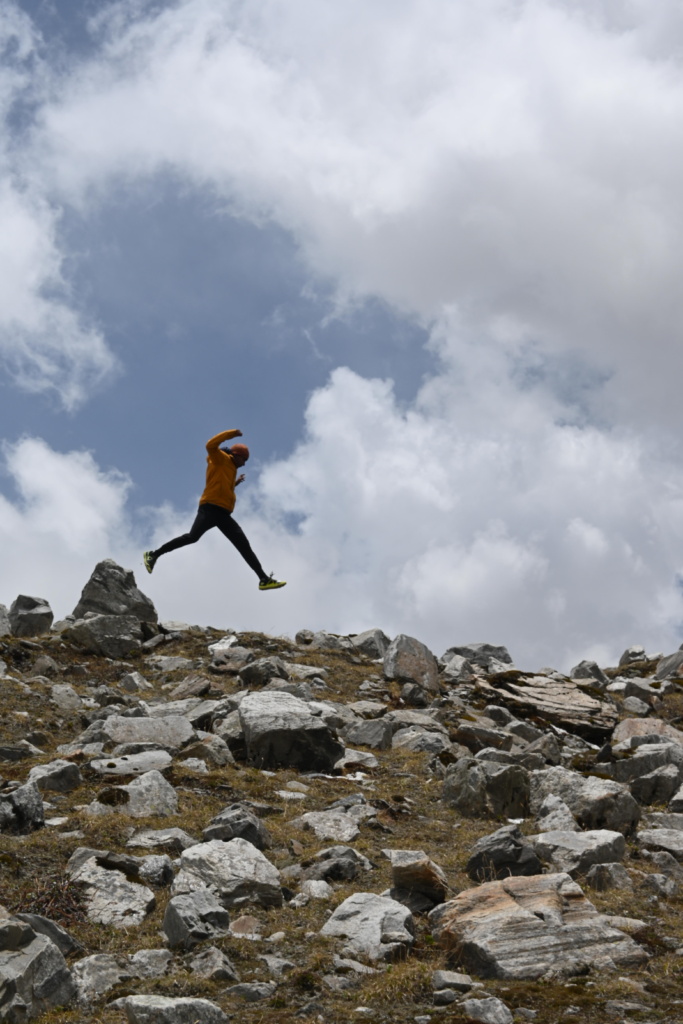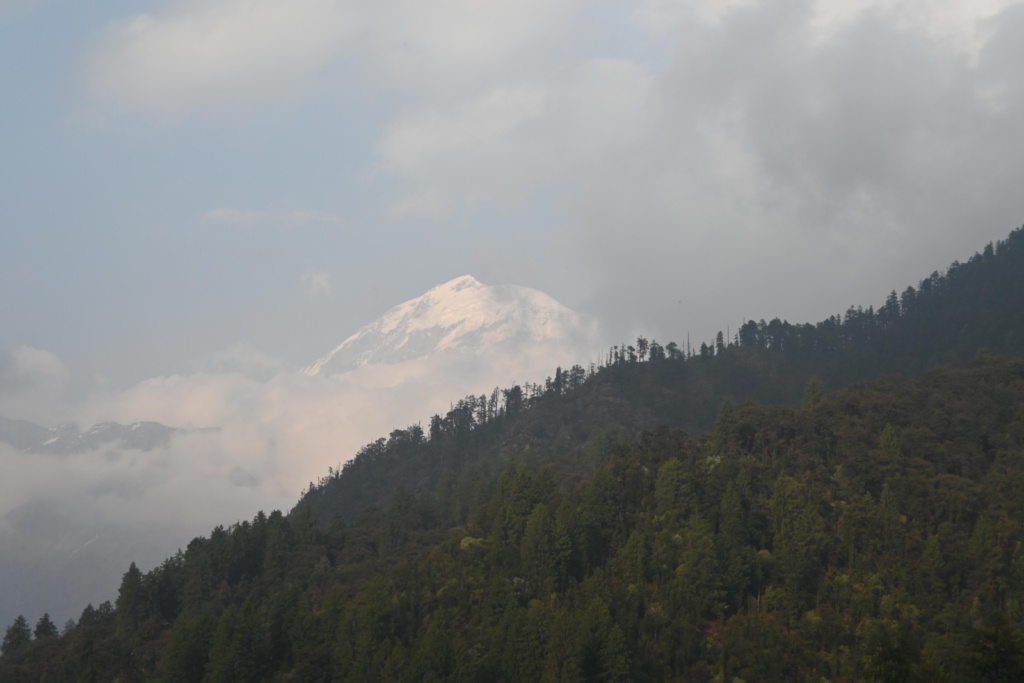The trail runner and mountaineer has trained his eyes on a speed ascent up Trisul I in Uttarakhand.

All photos: Shail Desai
First published: https://www.firstpost.com/living/trisul-i-abode-of-lord-shiva-and-a-test-for-mountaineers-10808321.html
Trisul I, abode of Lord Shiva and a test for mountaineers
Kieren D’Souza wants ‘to be out there climbing’ and Trisul I is a perfect recipe for the challenge he hopes to conquer
It was a late start to the morning for a motley bunch of visitors at Sutol, a remote hamlet tucked away in a distant corner of Uttarakhand. The previous day, Kieren D’Souza and his teammates had driven over 12 hours from the plains of Haridwar to get to this remote edge of the Garhwal Himalaya.
After a good night’s sleep, they were now off on a 26km hike to Homkund, a holy, high-altitude lake, where they would establish base camp. Over the next two weeks starting mid-May, D’Souza would train his eyes on climbing Trisul I – at 7,120 metres, it is the highest of the trident peaks.
However, this was unlike the conventional expedition-style climbs that the mountain has seen till date. The team would initially establish camps, while securing the route to the summit. D’Souza would then make a solo, speed attempt from base camp to the top and back in a single push. He hoped to achieve another first in the many that he had pulled off over the last few years and change the way climbing was approached in the Indian mountaineering space.
As things would pan out, unseasonal dumps of heavy snowfall put a spanner in the works. But D’Souza vouched to be back post monsoon to continue setting new benchmarks in the world of high mountains.

“There are certainly learnings and positives from this. At the same time, there is no harm in it being a failure because I am going to go back and get it done,” he says.
D’Souza’s appetite for adventure is something that he developed as a young boy. He had lapped up every book that came his way, whether it was on mountains like Everest or the plucky men and women who climbed it. These epics grew on him and over time, he longed to find his own path someday.
That opportunity first arrived in 2014 during a race in Ladakh when he observed the Stok Kangri peak in the distance from Leh and thought of climbing it. By then, he had been following the prowess of endurance athletes like Marc Batard and Kilian Jornet, who were making speed ascents on some of the biggest mountains in the world. Though still new to the world of trail running and mountaineering, D’Souza’s mind started working overtime. He wanted to hit new highs when it came to endurance, which demanded a mix of his running abilities as well as mountaineering skills.
“These projects are very different from all the racing that I’ve done. You tend to push hard during either, but the mindset is very different. Racing is a lot more controlled and stable, so you can go all out with nothing left in the tank by the end of it. Over here, your life is on the line a lot more, which means you cannot go overboard. You still need to be strong enough to get off the mountain,” he says.
Over the next few years, alongside honing his skills at some of the toughest trail and ultra races around the world, he also gained an understanding of what he would need to tackle serious altitude. A basic course in mountaineering had taught him the fundamentals of climbing, but a lot of the learning happened after he shifted base to Nasogi near Manali in 2015.
In 2020, when the COVID-19 pandemic brought a halt to all races around the world, D’Souza knew it was time to embark on the projects he had been toying with. At the heart of it, he wanted to be a part of the revolution unfolding in the world of mountaineering, hoping to open up the space for other dreamers like him.
“The idea was to do something within my capability, which is still very current in mountaineering. Speed ascents sounded very exciting to me. It wasn’t something that happened overnight – it kept eating at me for months, until one day, I decided to make it happen,” he recalls.
D’Souza decided to build from the bottom. He first summited Friendship Peak (5,290m) and Deo Tibba (6,001m) in Himachal Pradesh in under 24 hours – most climbers take days to accomplish. He followed it up by climbing ten peaks of over 6,000 metres in Ladakh in just 26 days. The next logical progression was to make a similar speed attempt on a 7,000 metre peak.
“There were a few mountains that I considered. But the more I read about Trisul, the more attractive it felt given its history,” D’Souza says.
Trisul has enticed adventurers for over a century now. It was the first 7,000 metre mountain in the world to be climbed when English explorer, Tom Longstaff, made the top in 1907. After India’s independence, the first indigenous team comprising members from the Doon School in Dehradun succeeded in 1951 – that expedition is best remembered for the sirsasana that legendary climber, Gurdial Singh, performed on the summit. A number of teams have made the top of Trisul since then. But there have been several unsuccessful attempts as well, owing to the tricky terrain higher up and a complex weather system that the peak draws. Just last year, members of an Indian Navy team were swept away by an avalanche, resulting in several casualties.
The mountain’s aura was enough to have D’Souza’s attention. During a holiday in December last year, he started plotting his speed attempt for the summer of 2022.
“I spoke to a number of people who’ve climbed Trisul, sourced images from them and looked up the route on Google Earth. A team member also made a recce trip in April and brought back photos from the mountain. So we picked up titbits of information from various sources to understand what we could expect. But a lot of it could be figured out only once we had set foot on the mountain,” he says.

As they set off from Sutol, Trisul made a brief appearance from behind the clouds, as if to get a glimpse of this suitor, before tucking in for the day again. Locals in the region believe the mountain to be the home of Lord Shiva, the plumes blowing across the summit each morning conjured up to be him smoking his pipe. At Tatala camp later that day, D’Souza had his first real feel of the peak.
“I thought I had seen big mountains, but Trisul is massive. It’s a little scary because it’s a big piece of rock; at the same time, it’s really exciting to think that I would be up there,” he says.
The march to base camp was pulled off in three days. The very next morning, the team started up the scree slopes that topped out at a steep gully leading to Camp 1. There was the constant threat of rockfall, even as booming avalanches made their presence felt around the valley. The idea was to set up intermediate camps en route the summit and understand the kind of gear that D’Souza would need to tackle the technical terrain while making his solo push. Climbing with a team is one thing, but tackling the elements at that altitude – alone and while in search of speed, flow and efficiency – is a wholly different game that he thrives on.
“I’ve tried to function as an athlete for over a decade now. At the crux of it, I like to push myself hard and see where my limits lie. And I’ve chosen to do that in the mountains,” he says.
After stocking Camp 1, they descended to base camp by evening. Overnight snow called for a day’s break, before they could continue making progress on the mountain. The route from Camp 1 to Camp 2 was dotted with gaping and hidden crevasses alike, forcing the team to rope up to avoid mishaps. They got to within 50 metres of Camp 2, but impending bad weather forced them to turn around yet again. That night, around a foot of snow was dumped at base camp, which meant rapidly changing conditions higher up on the mountain. With more precipitation predicted over the next few days, the team descended to recuperate at base camp.
The short, intermittent windows of good weather hampered their progress on the whole. A runner from Sutol brought dismal news of more snowfall in the days ahead. And with the permit running out on 31 May, D’Souza was left with a tough decision to make.
“I feel alive in bad weather. But it was soon evident that we had little time on hand – perhaps enough to make the summit, though certainly not to make the speed attempt. And for me, it was important how I got to the top. The hardest thing was to take a call on pulling the plug – post that, it was down to preparing and planning things better,” he says.

Post monsoon, D’Souza hopes to be back on Trisul. The ultimate goal is to make a speed ascent next year on Everest. The disappointment is evident, but it’s more to do with the tedious task of putting together resources, rather than the physical effort that the next attempt would entail. It’s a constant battle that he’s had to deal with since he first started running.
“When I decided to do this full-time, I was prepared to be doing a lot of things while I was really broke. It’s a little annoying to have this as an obstacle. But it’s certainly not hard to be motivated,” he says.
“At the crux of it, I want to be out there climbing and in this fashion. And in the future, I hope there are other people doing similar exciting things on our mountains,” he says.